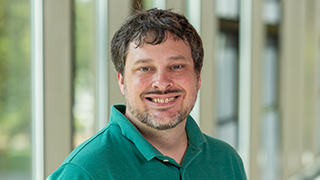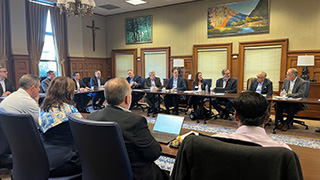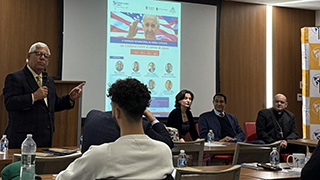Computational Biologist Uses AI to Explain Evolutionary Complexity
Friday, April 4, 2025
 In an era where artificial intelligence and computational biology are transforming
scientific research, Bradley Martin, Ph.D., is a leader in the research-driven integration of artificial intelligence
with large-scale genomic datasets. With a background in molecular ecology, genomics
and bioinformatics, his research explores the evolutionary dynamics of hybridization
and adaptation in reptiles and other animals. By integrating artificial intelligence-driven
methodologies with large-scale genomic datasets, Martin explores mechanisms shaping
biodiversity in the face of environmental change.
In an era where artificial intelligence and computational biology are transforming
scientific research, Bradley Martin, Ph.D., is a leader in the research-driven integration of artificial intelligence
with large-scale genomic datasets. With a background in molecular ecology, genomics
and bioinformatics, his research explores the evolutionary dynamics of hybridization
and adaptation in reptiles and other animals. By integrating artificial intelligence-driven
methodologies with large-scale genomic datasets, Martin explores mechanisms shaping
biodiversity in the face of environmental change.
Though artificial intelligence and its many applications across industries came to the public consciousness more acutely over the past few years, Martin notes that he has been engaged with this kind of research longer than most. “I actually started working with artificial intelligence software before ChatGPT came out — before it was cool,” he says. “In 2020 or 2021, I used artificial intelligence algorithms to perform species delimitation analysis and compared several artificial intelligence algorithms.” Species delimitation analysis, he explains, “is common in systematics, phylogenetics-type analysis or type studies, where you're trying to delineate what are separate groups and what are the same groups.” These studies and methodologies, Martin says, play into species-based conservation efforts, which is where biology comes into his research equation. It all began, Martin recalls, when he stumbled upon a paper that he wanted to explore and published a study comparing artificial intelligence algorithms related to species.
Martin also imbues his work creatively and enjoys naming his predictive missing value software with catchy acronyms that those outside the computational biology world will recognize and smile about once explained. For example, Martin called one of his software pieces PGSUI (pronounced “pig suey”) after the Arkansas Razorbacks slogan, “Woo, pig suey!” PGSUI stands for Population Genomics, Supervised and Unsupervised Imputation.
Before earning his doctorate in biology at the University of Arkansas, where he studied the evolutionary history of North American box turtles within a hybrid zone in the Southeastern United States, Martin conducted undergraduate and master’s research with his mentor, John S. Placyk Jr., at the University of Texas at Tyler. Together, they conducted phylogenetic and population genetic analyses on North American box turtles, leveraging Sanger sequencing techniques to re-evaluate species classification. It was this research that charted Martin’s evolving path in evolutionary biology, molecular genetics and later, computational biology. It was a first-year class at Tyler that sparked his interest in biology — so much so that Martin pivoted from his original intention to become a dentist.
At Seton Hall University, Martin is committed to the education and mentorship of both undergraduate and graduate researchers. Teaching genetics, biostatistics, human genetics and ethics in research, he broadens students’ understanding of computational biology by emphasizing the importance of data-driven approaches in genomics. Current undergraduate students are working on software that runs population genetic analysis, loads various file formats and filters data. “That’s called SNP IO, meaning input output, and then snip — the type of genetic variant that works with SNPs, or single nucleotide polymorphisms,” he explains. His students are working to validate Martin’s software and explore datasets, which provides important real-world analytics experience and training.
One of Martin’s primary goals is equalizing computational methods so that all scientists can access and leverage artificial intelligence in biology studies. “I'm very big on user friendliness,” he says. “I like people to not have to get frustrated using my software and, unfortunately, in biology there's a lot of software out there that was written by biologists who aren't necessarily coders […] so they don't necessarily make it the easiest to run.”
This drive to create access for all is tied to his constant efforts to improve his research and methodology. Describing himself as shy in his younger years, Martin credits his friendliness and willingness to learn new things, as well as taking on challenges, as core character assets. He is hard on himself, he says, because he often feels he could “do better.” “I'm always wanting to improve…trying to expand my skill set.”
Looking ahead, Martin hopes to further integrate artificial intelligence-driven analytics into evolutionary genetics, with current lab work focused on refining machine learning techniques to enhance species identification, detect cryptic hybridization events and predict adaptive responses to climate change. His goal? “After developing my suite of software [for which SNP IO is the entry point], I want to move everything to the cloud,” he says. “I want users to be able to upload their data, where my trained models will make predictions on their data and send it back to them. I think that's the next step in artificial intelligence development and computational biology.”
Categories: Research, Science and Technology






